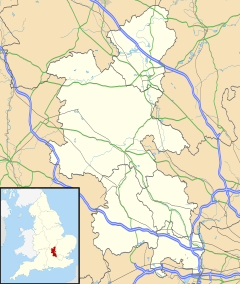Quarrendon facts for kids
Quick facts for kids Quarrendon |
|
|---|---|
 Ruins of St Peter's parish church |
|
| Population | 44 (Mid-2010 pop est) |
| OS grid reference | SP8015 |
| Civil parish |
|
| Unitary authority |
|
| Ceremonial county | |
| Region | |
| Country | England |
| Sovereign state | United Kingdom |
| Post town | Aylesbury |
| Postcode district | HP19 |
| Dialling code | 01296 |
| Police | Thames Valley |
| Fire | Buckinghamshire |
| Ambulance | South Central |
| EU Parliament | South East England |
| UK Parliament |
|
Quarrendon, also known as Quarrendon Leas, is a fascinating old English village. It's located near Aylesbury in Buckinghamshire, England. This village became empty in the 1500s and is now a special protected historical site called a scheduled monument.
Contents
What is Quarrendon Today?
Today, Quarrendon is a large area of fields and meadows. It provides a green space between Meadowcroft and Central, on the edge of Aylesbury town. In these fields, you can still see the remains of a medieval village. There are also ruins of a church, a manor house with its moat, and a Tudor water garden.
These historic features are now protected by the government as a scheduled monument. This means they are very important and must be preserved. The area is also home to various wildlife. The River Thame forms the southern border of this interesting site.
Discovering the Deserted Village
The way Quarrendon village was laid out in the Middle Ages can still be seen today. You can spot the shapes of old buildings and roads in the ground. Back then, the village had farmhouses grouped around oddly shaped green areas. Sunken roads connected these farms to each other, to their fields, and to Aylesbury.
This village grew over many centuries. Its design and how people lived there likely changed over time. The visible earthworks are important clues to the past. But there are probably more hidden items and structures underground. Archaeologists might discover these in the future. Some important parts of the village are outside the protected area. These areas also need careful management. For example, a field nearby shows "ridge-and-furrow" patterns. These patterns are signs of a medieval open field system of farming.
Historians believe there were two deserted village sites here. They think the medieval settlement moved from one spot to another. The smaller site is west of the ruined Church Farm building. It has flat areas where houses once stood and an old trackway. On the western edge, a wide, flat area might have been used for animal pens. The second, larger village site is to the east. It is thought that the villagers moved here from the original settlement. The village was likely abandoned around 1485.
The old streets and house plots are clearly visible in the ground. The village covered about 25 acres (10 ha). Its streets and small farm plots spread out from a pond with a mill. A main sunken street ran westwards from the village up the hill to the manor house. You can also see the ruins of a small 13th-century church, called St Peters Chapel.
The Tudor Manor and Water Gardens
In 1499, King Henry VII took control of the lands around Quarrendon. He had taken them from the Earl of Warwick. Richard Lee was then given a special lease to use Quarrendon. Richard Lee's son, Sir Robert Lee, became the Sheriff of Buckinghamshire. He built a new moated house and garden on the site. The moat still exists and is partly filled with water.
Sir Robert's grandson, Sir Henry Lee, inherited Quarrendon in 1549. He created amazing gardens with canals and raised pathways. Sir Henry even replaced parts of the old medieval village with a large rabbit warren. He also built a grand water garden with high, banked walkways. After Sir Henry died in 1611, Quarrendon began to decline. The grand mansion was eventually replaced by a farm.
Quarrendon's Role in Battle
An earthwork in the Quarrendon area was used by the Royalist soldiers. This happened during the Battle of Aylesbury on November 1, 1642.


